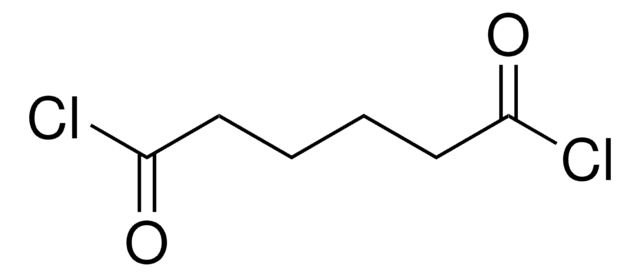422002
Hexamethylenediamine
technical grade, 70%
Sinônimo(s):
1,6-Diaminohexane, 1,6-Hexanediamine, HMDA
About This Item
Produtos recomendados
grau
technical grade
Nível de qualidade
densidade de vapor
4 (vs air)
Ensaio
70%
forma
liquid
Lim. expl.
6.3 %
técnica(s)
gas chromatography (GC): suitable
índice de refração
n20/D 1.439 (lit.)
pb
111-130 °C
pf
42-45 °C (lit.)
solubilidade
alcohol: soluble(lit.)
hydrocarbons: soluble(lit.)
water: soluble(lit.)
densidade
0.89 g/mL at 25 °C (lit.)
grupo funcional
amine
cadeia de caracteres SMILES
NCCCCCCN
InChI
1S/C6H16N2/c7-5-3-1-2-4-6-8/h1-8H2
chave InChI
NAQMVNRVTILPCV-UHFFFAOYSA-N
Informações sobre genes
rat ... Ppm1a(24666)
Procurando produtos similares? Visita Guia de comparação de produtos
Descrição geral
Aplicação
- polyamides and their hydrolytic and fungal degradability was investigated
- mullite ceramics
- dialkyl hexamethylene-1,6-dicarbamate (AHDC), via trans-esterification reaction of HDA and alkyl carbamates (AC) using FeCl3 as catalyst
Outras notas
Palavra indicadora
Danger
Frases de perigo
Declarações de precaução
Classificações de perigo
Acute Tox. 4 Oral - Eye Dam. 1 - Skin Corr. 1B - STOT SE 3
Órgãos-alvo
Respiratory system
Código de classe de armazenamento
8A - Combustible corrosive hazardous materials
Classe de risco de água (WGK)
WGK 1
Ponto de fulgor (°F)
201.2 °F
Ponto de fulgor (°C)
94 °C
Escolha uma das versões mais recentes:
Já possui este produto?
Encontre a documentação dos produtos que você adquiriu recentemente na biblioteca de documentos.
Os clientes também visualizaram
Nossa equipe de cientistas tem experiência em todas as áreas de pesquisa, incluindo Life Sciences, ciência de materiais, síntese química, cromatografia, química analítica e muitas outras.
Entre em contato com a assistência técnica















